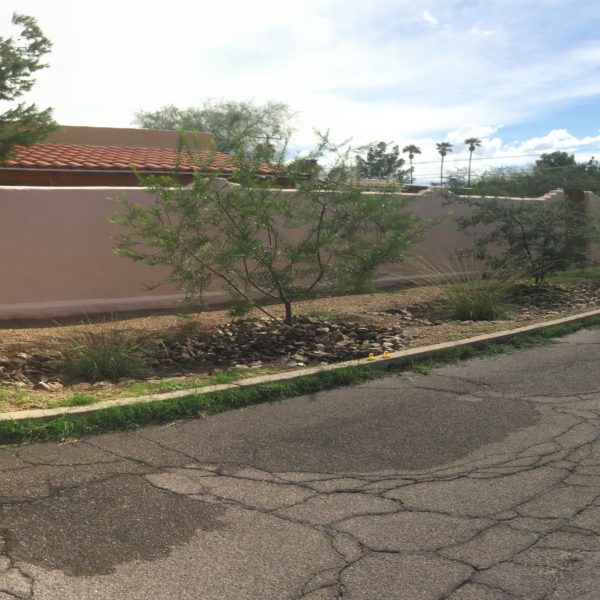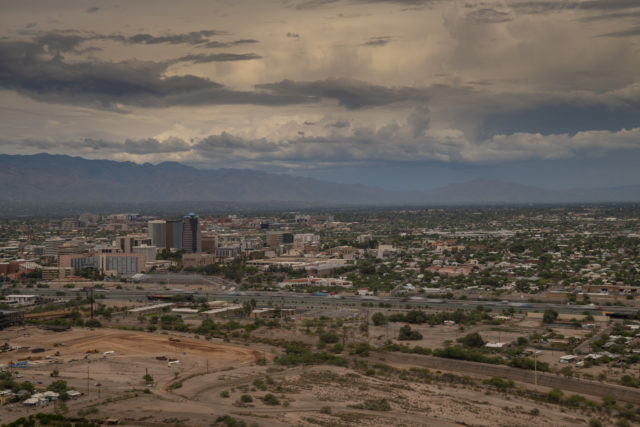“For me, one of the coolest parts about the project is that we’re creating something beautiful.”
—Allie Silber, teacher at Tucson’s Sky Islands High School
Water is the Southwest’s most precious resource, but if you live in Tucson or other urban areas, you know that a lot of rainfall can quickly become too much of a good thing.
With so much land now paved and built on, the natural hydrology of stormwater in our urban areas has changed. Instead of filtering into the ground and gently filling washes to flow to rivers, stormwater pours off rooftops and across parking lots and cascades into streets. Its force overwhelms and erodes washes, carries away soil needed to support greenery, and flushes contaminants into waterways and into the Santa Cruz River.
The human cost of flooding is also high. Along with the immediate danger and property damage, flooding can gradually lead to community blight. This is especially true in areas close to washes and arroyos, where flood potential makes it too dangerous to build houses or businesses. As a result, this land is often left empty and unattended. Without efforts to keep these spaces clean and maintained, they become barren, eroded eyesores.
Fortunately, an innovative program that the Sonoran Institute helped pioneer is working to prevent and reverse this type of damage. Conserve2Enhance (C2E) provides money and support to community groups that want to beautify degraded land and restore damaged washes in urban neighborhoods.
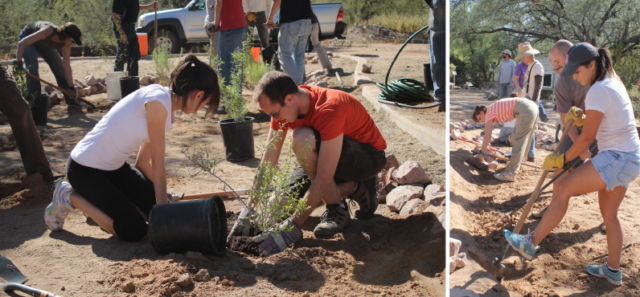
A Unique Way to Pay for Conservation Projects
The idea for the C2E program emerged from a 2008 University of Arizona Water Resources Research Center (WRRC) study that examined a common conflict people face when they make the effort to conserve water.
“Many people feel like they are doing the responsible thing in conserving water but don’t see how their actions have a broader benefit,” explains Ashley Hullinger, research analyst at WRRC. “They ask themselves, ‘Why should I conserve my water just so it can go toward enabling more development?’ We developed C2E as a way for people to make a more direct environmental impact in their own community.”
C2E encourages water consumers to take steps to conserve water–like upgrading to a low-flow toilet or installing a rainwater harvesting system–and then to donate the resulting savings on their water bill to the program. People can also simply check a donation box on their water bill. C2E then reinvests in conservation by providing grants for local environmental enhancement projects.
“People who make personal changes to conserve water often want to make a bigger impact beyond saving a few bucks,” says Claire Zugmeyer, Sonoran Institute ecologist and longtime C2E partner. “By adding their donation to a whole city’s worth of contributions through C2E, they can be part of something much more meaningful.”
Sonoran Institute was one of the first organizations to join C2E, and together with WRRC, Tucson Water, and another conservation organization—Watershed Management Group—helped launch a pilot project to test the concept in Tucson. In addition to working with the other partners to design the project, Sonoran Institute provided stipends to help fund customers’ initial conservation measures. The pilot proved successful, and Tucson C2E became the first Conserve2Enhance program in the nation in 2011. Since then, five other C2E communities have formed, four in Arizona and one in Mexico’s Colorado River Delta.
Sonoran Institute has been actively involved with the Tucson C2E program ever since, including have a presence on its board for the first eight years. “They have really invested their staff time in making the program possible,” says Lisa Shipek, executive director of the Watershed Management Group. “Sonoran Institute has always been great to collaborate with, not only helping provide resources for the projects, but also the staff. They work alongside our staff and alongside the volunteers that come out, and they bring their watershed health and river restoration expertise to bear on the projects. It’s really been a nice partnership.”
Slowing and Spreading Water to Make Neighborhoods Green
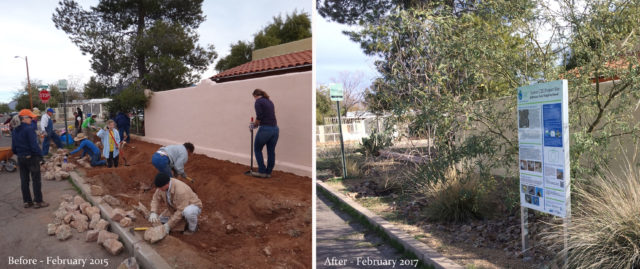
One of the biggest problems with urban stormwater is how fast it disappears. Because it rushes into washes, flows into the nearest river, and quickly leaves the area, water does not have the opportunity to soak into the ground to replenish groundwater supplies that support vegetation. That’s part of the reason empty land near washes looks so shabby. These areas lack good shade trees and flowering shrubs for pollinators, and end up being places that no one wants to go or pay attention to.
“One way to heal the watershed is to slow and spread the water upstream from the river, so water stays in the watershed longer,” says Zugmeyer. Slowing and spreading water rebuilds healthy soil. Better soil supports plant growth, and plant growth helps further slow water, diminishing its erosive power and flooding potential. Having lots of trees also provides shade, reducing urban heat issues.
Building rainwater harvesting basins along the side of the street is one way to accomplish this. The Jefferson Park neighborhood in central Tucson built four of them with the goal of transforming what was a strip of dirt into a tree-lined corridor that will offer a shady place to walk while providing habitat to birds and other wildlife. A brigade of neighbors dug the basins, lined them with rock, and then drilled holes in the road’s curb.
Now, instead of rushing down the street, some of the stormwater flows through the holes, fills the basins, and seeps into the ground. The soil naturally filters and cleans the water, while the water irrigates the trees and shrubs that volunteers have planted there.
Connecting Water Conservation to Community Action
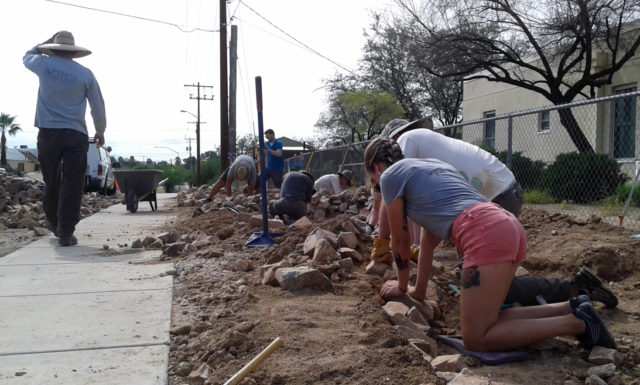
C2E brings neighbors together. In fact, a statewide survey of C2E programs in 2015 found that C2E has been extremely successful as a community-building tool. This is because, aside from the funding and knowledge that C2E shares, the projects are entirely community-run.
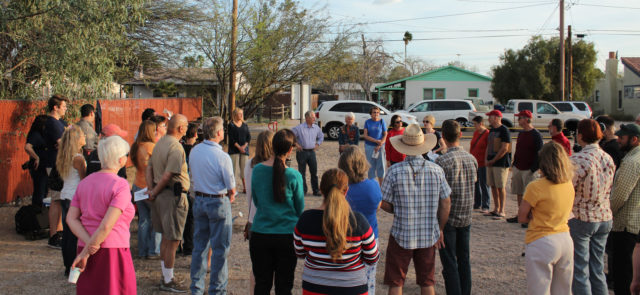
“Community building and conservation by learning are the strongest and most successful parts of the program,” says Ashley Hullinger of WRRC.
Neighbors in the Palo Verde neighborhood in central Tucson came together on a C2E project to convert blighted land into a highly valued neighborhood asset: the only park in the area. Neighbors met each other while digging basins, planting trees and shrubs, and installing benches and signage. Now they spend time together enjoying the park with their families.
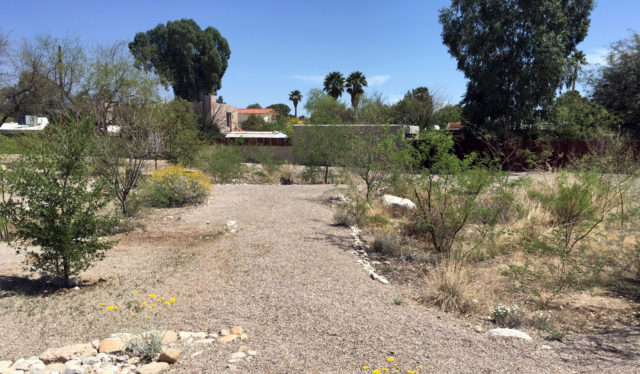
“The Palo Verde project was definitely a huge success for the program,” says Shipek. “The neighborhood has been very engaged, not only in installing the project but in maintaining and improving the park every year.”
Inspiring and Teaching the Next Generation
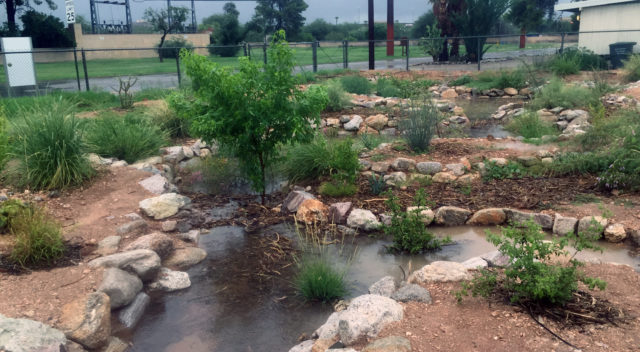
Seeing an opportunity to harness stormwater that flows down the driveway and divert it to beautify the landscape, Sky Islands High School teacher Mike Bagesse applied for a Tucson C2E grant in the spring of 2015. The following fall, he and colleague Allie Silber designed an arid land management class around the project. Students learned everything necessary to develop the rainwater harvesting site into a working landscape. The curriculum included earthworks, berms and basins, curb cuts, native plants of Arizona and their various water requirements, irrigation, and how arid land management differs from land management in different climates.
Since then, the school has planted shrubs, cacti, and over 40 trees. Native grasses and small shrubs have sprouted up on their own, thanks to the newly available water in the landscape. Teachers throughout the school use the landscape as a teaching tool.
“For me, one of the coolest parts about the project is that we’re creating something beautiful by bringing more native plants to the space, and as a result, more butterflies,” says Silber. “The environmentalist in me loves that, and the teacher in me really loves that I have space, a three-minute walk away, that I can bring my students to explore all sorts of ecosystem functions.”
Bringing it All Together
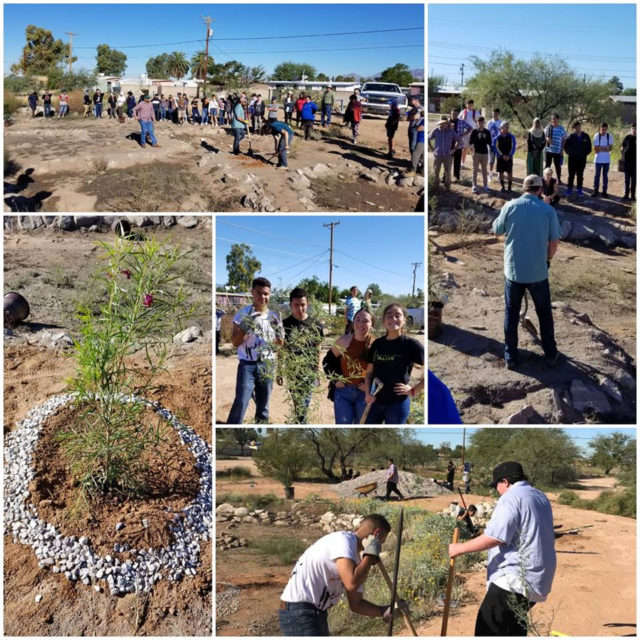
The largest and most complex project in the history of the Tucson C2E program began when a Changemaker High School student had to walk through floodwater on the way to school. Whenever it rained, the wash running through Swan Park near the school would flood, cutting off a main pedestrian thoroughfare and route to school. After her soaking, the school found funding to build a footbridge over the wash so people could get back and forth safely, and then set about addressing the underlying flooding problem.
Swan Park has two parcels. The east parcel is well manicured, featuring palm trees and Bermuda grass; the west parcel was an eyesore, growing nothing but unsightly, invasive weeds. “There was no wildlife. Not even pigeons went there,” says Nicole Snook, Changemaker High School science and service learning teacher.
Changemaker received funding from Tucson C2E in 2016 to reshape the flow of the wash in order to reduce flooding and bring the other half of the park back to life. Such an ambitious project requires a true community-wide effort. Students, alumni, and community volunteers have joined forces to create four massive water harvesting basins, reinforced by 130 tons of rock. The native trees, grasses, and other vegetation they have planted will attract people and wildlife while keeping water in the wash instead of in the street.
“The mission of our school is to develop student leaders who turn ideas into action,” Snook says. “That’s what this project is all about.”
A Call to Action
If water in the urban Southwest is a paradox of being too much while also too little, C2E is its elegant solution. By turning individuals’ water conservation into community enhancement, C2E enables neighborhoods and schools to beautify land while controlling flooding, to build parks while restoring waterways, and to foster learning and friendships while creating shade.
Participation is the key to unlocking C2E’s enormous potential. University of Arizona research indicates that if just 5% of customers in the Tucson Water service area join Tucson C2E, they would conserve an estimated 250,000,000 gallons of water annually and provide more than $500,000 for restoration projects each year.
“If you live in Tucson or one of the other C2E communities, we hope you will join the effort,” Claire Zugmeyer says. “Check the donation box on your bill, become a Tucson C2E member or volunteer, spread the word at your Neighborhood Association meeting. This is still a fairly small program, but it can do so much more.”
Current C2E Programs are: Arizona Audubon C2E, Arizona Water Sentinels, Flagstaff C2E, Raise the River, Tucson C2E, and Yavapai C2E

